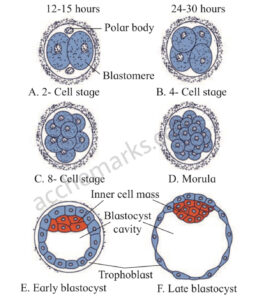
After syngamy, the zygote becomes active and starts dividing.
1. Cleavage:
Cleavage is the initial mitotic division of the zygote, forming a hollow multicellular blastula. Blastomeres, the cells produced, decrease in size with each cleavage due to the absence of a growth phase.
As size reduces, metabolic rates increase, leading to faster successive cleavages. This demands rapid DNA replication and high oxygen consumption.
2. Process of Cleavage:
In humans, cleavage is holoblastic, involving the entire zygote. Cleavage planes can be longitudinal or meridional and equatorial or horizontal. It is radial and indeterminate.
The 1st cleavage occurs meridionally around 30 hours post-fertilization, resulting in two blastomeres.
The 2nd cleavage is longitudinal but at a right angle, happening after 30 hours of the 1st cleavage.
The 3rd cleavage is horizontal, reaching the 8-cell stage. By the 4th day, the embryo is a solid ball of 16-32 cells, resembling a mulberry, known as a morula.
3. Morula:
The morula exhibits two cell types: smaller, clearer cells on the outer side and a larger inner cell mass. Cells are compactly arranged.
The zona pellucida is retained until morula formation, maintaining the overall size. The morula enters the uterus by the end of day 4 after fertilization.